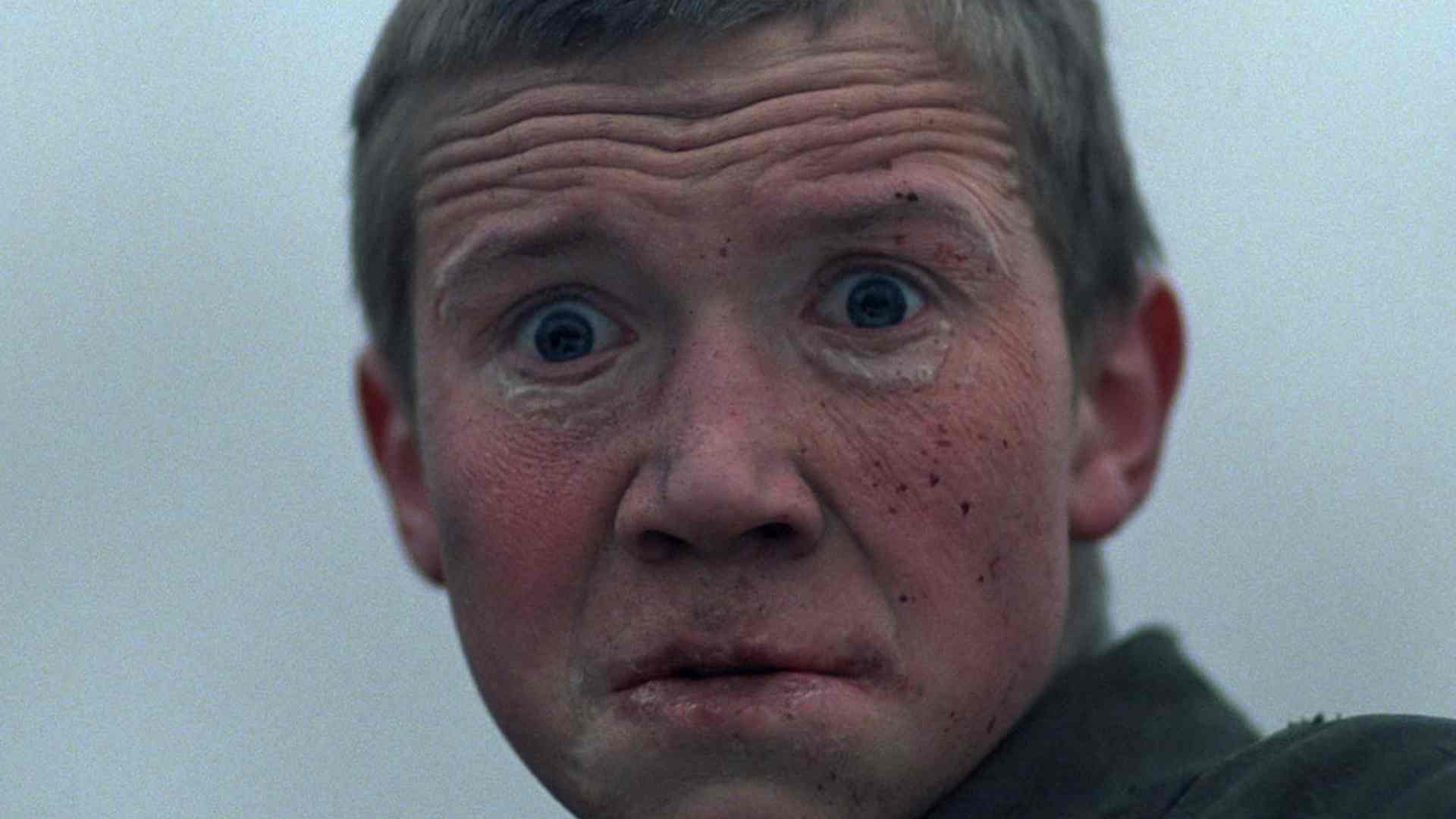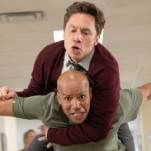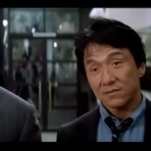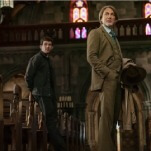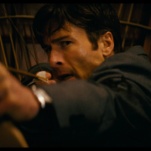While Come And See‘s reputation now precedes itself, in particular with young, more online cinephiles, that notoriety wasn’t created overnight. In tomes like Birgit Beumers’ A History Of Russian Cinema or Peter Rollberg’s exhaustive The Historical Dictionary Of Russian And Soviet Cinema, Come And See appears as a blip, rarely occupying more than a paragraph. Even though it was well-received, the 1985 film does not warrant special note; it’s seen mostly as a stepping stone towards filmmaker Elem Klimov’s role as a bureaucrat. This is in part because it was not as much of a departure from the rest of the Soviet industry as a modern audience might think. Its Steadicam-filmed, naturally lit aesthetics were common; its bleak portrayal of war par for the course. In They Fought for Their Country, Sergei Bondarchuk’s WWII movie from 10 years prior, the director’s character asks, “What have the bastards reduced me to?” and the film concludes with the company’s officer telling his men that “Our motherland will never forget your great efforts and your suffering.” It’s much more on the nose, but completely in line with the message of Come And See. Yet, because of its formal stringency, Come And See has come to be seen (in the last decade especially; it currently sits at number three on Letterboxd’s Top 250 narrative features of all time) as totemic, one of the world’s best war movies—if not the best ever.
After sharing the top prize at the 14th Moscow International Film Festival 40 years ago, the film saw widespread success in the U.S.S.R. but was basically obscure outside the former Soviet states until the 21st century. The film—following young Belarusian boy Flyora (Aleksei Kravchenko), who witnesses the increasingly nightmarish horror of war during the Nazi invasion of his country—would attract new attention, particularly in the United States, after its 2002 DVD release.
At that time, critics like The A.V. Club‘s Scott Tobias noted that the film acts as something of a “Russian cousin” to Apocalypse Now—a kind of ultimate anti-war statement by the Soviets in the way that Apocalypse Now was for Americans. Perhaps unwittingly, the equivalence also highlights the more problematic perspectives of each, which quietly saddle both works with contextual baggage. Apocalypse Now has the same issues as its loose source, Heart Of Darkness, which argues against colonialism from the perspective of the colonizer—a fundamentally difficult position given that the horrors of that ideology obviously would weigh heavier on those being dominated than on the invaders. For Western audiences, though, the complications and contradictions within Come And See are less apparent.
Come And See, like Apocalypse Now, moves like a descent deeper into Hell. If Coppola’s film is a dark ride at a twisted amusement park, taking a boat trip through a fictionalized Mekong River, Come And See is like running through a fog-covered, bog-soaked nightmare landscape where death is always creeping in from just outside the frame of Aleksei Rodionov’s ghostly Steadicam. That is, until that specter of destruction itself emerges like a cruel carnival coming to town. The SS soldiers are debauched, cackling, drunken murderers, laughing and jumping with joy as they fire machine guns into a barn church that they’ve set ablaze with an entire village’s population inside. This is not the cold, mechanical genocide often portrayed in media about the Nazis, but one that terrifyingly takes joy in its own libidanal cruelty.
Witnessing this massacre robs Flyora of any last semblance of being a child, his face permanently molded by the apocalyptic horrors. After the partisans counterattack and vanquish this SS detachment, Flyora searches among the wreckage for supplies, finding a young boy who resembles himself from earlier in the film. The contrast calls to mind the infamous photos of Soviet soldier Yevgeny Kobytev, and the way his face grew haggard after only a couple years of war. Come And See is intended to have a similar effect on viewers, leaving them forever changed by what they’ve seen.
That explains why, in the present, the film has become such fodder for reaction content. A quick search on YouTube reveals innumerable videos—from accounts with names like Cinema Rules, James VS Cinema, and My Egyptian Dad Reacts—of people filming themselves watching Come And See for clicks. While the film existed in the earlier parts of the 21st century as a cult film with a strong reputation from critics like J. Hoberman and Roger Ebert, or writers like J.G. Ballard, it wouldn’t be until the Criterion 4K release of the film (which made the image quality palatable to contemporary tastes compared to the notorious muddiness of the Kino Lorber disc) that the film would explode in popularity.
Counterintuitively, it also helped that Janus was in the midst of Come And See‘s theatrical re-release when COVID struck, allowing the film (now more available than ever) to take on new life as something experienced by way of other people’s reactions. If Come And See is now a poster child for “shock” films, then it should be noted that everything that falls into that loose category, one often defined more by reputation than intention, all have overt political inclinations. From the Mondo movies that initially defined this “genre,” to Pier Paolo Pasolini’s anti-fascist masterpiece Salò, Or The 120 Days Of Sodom, to the similarly De Sadian A Serbian Film (which also became a focal point for reaction content on the earlier days of YouTube, working as a primer for Come And See‘s current position), films which intend to shock contain attacks on sensibilities.
Come And See‘s shock is historic: The film is inspired by Belarusian writer Ales Adamovich’s own experience as a teenage partisan in WWII, along with his own archival research towards understanding the genocide committed on his homeland through the Nazi Lebensraum, which sought to permanently displace and ethnically cleanse non-Aryans from Eastern Europe. It is a chapter in the war that is often overlooked in American or Western European histories, but to the Soviets, the war was existential in every sense. Nazis sought to destroy both their ideology and their people.
The film’s greatest shock is not one of its captured images, or even its archival footage of the Holocaust, but a title card that comes at the end. Flyora gazes upon a portrait of Hitler, shooting it repeatedly with his rifle, and the film starts to play newsreel footage of the war in reverse, going all the way back through the rise of the Nazis, the First World War, and finally ending with Flyora gazing at Adolf Hitler as an infant, their eyes strikingly matching. Flyora looks up from this montage into the camera, directly at the audience. The screen goes black. Red letters appear: “628 Byelorussian villages were burnt to the ground, along with all their inhabitants.” The horrors we have seen are but a glimpse of their full scale. This historical fact, however, has also been co-opted for more sinister purposes.
There’s a bad-faith debate in Germany about the death count from the firebombing of Dresden. The purpose of this for the far-right is to portray Germans as victims of WWII, rather than perpetrators. The myth of Dresden’s death toll being over 100,000 (instead of 25,000—the higher number often used to make equivalences to those killed in Hiroshima) is perpetuated in the American consciousness by Kurt Vonnegut with his novel Slaughterhouse-Five, in which he claims that 135,000 people were killed in the firebombings, a number he drew from the Holocaust denier David Irving. While the numbers in Come And See are accurate, they can similarly be used to limit perspective on the war to a dangerous degree.
In Russian historiography, the country is always perceived as under threat of total destruction by outside invaders. This is in part because of geography, with how the vast majority of the country’s population lives on the relatively flat (and easy to invade) western plains, but it also does have precedents in history that have been restaged for mass entertainment: Teutonic invaders destroy medieval Russian towns in Sergei Eisenstein’s Alexander Nevsky much the same as Nazis do in Come And See.
After the Russian Revolution and Civil War, the burgeoning state had to decide the nature of its future. On one end was the internationalist camp, which sought to continue its vanguard revolution and foment similar socialist uprisings across the world. On the other was the idea that would ultimately win out, Stalin’s “socialism in one country,” which was an isolationist mentality that first sought to secure the Soviet Union’s self-sufficiency. This also coincided with threats first from capitalist, then fascist nations, which cemented a militarist mentality in the country, which has retroactively come to be known as “siege socialism.” Come And See, while foregoing portraying valor in combat, still fits into this ideology.
The destruction in the film leads to a postscript after the final title card: Flyora running through the woods to link back up with the partisans. As Mozart’s “Requiem” plays, the camera glides away from the soldiers and under the dark trees. When it begins to emerge, the landscape and the piney branches are suddenly covered in snow. We have moved through time, and the soldiers are still running through the forest, seemingly endlessly—the war, it would seem, is never over. This is how the Soviet state as a militarist entity saw itself, albeit with the ultimate goal of spreading communism. After the collapse, that socialist militarism turned into an ultra-nationalist one, leading to Balkanized conflict after Balkanized conflict, with the children of former comrades killing each other in trenches all across eastern Ukraine.
While often seen simply as a polemic against the horrors of war, the film still fits neatly into a culture that has itself created a modern, never-ending meat grinder for human life. But, unlike how scenes from Apocalypse Now have been co-opted to make points counter to what the film is trying to say (think the young Marine recruits in Jarhead cheering to the “Ride Of The Valkyries” sequence), Come And See is instead a film masquerading as purely anti-war through its formal conceits, which distract modern audiences from its militarist context. That is to say, despite its recent perception and popularity, Come And See should not be viewed as the be-all-end-all of war films, but as a single, specific, and culturally contextual perspective on World War II. Its visceral experiment in conveying the horrors of war is successful, but maybe too successful given how that has led to the film being reduced to something upsetting that content creators can react to.
In 2025, 40 years since its release, its images have stark resonances, the blighted environment and mass death perpetrated by the Nazis calling to mind contemporary images of Gaza. Is anything closer in the present to the image of villagers being herded to their deaths in Come And See than the IDF and American contractors using an aid distribution site as a killing field for Palestinian civilians? Yet now, perhaps more than at any point in the film’s history, it is important to also recognize the patriotic leanings of Come And See, given how the far-right has taken a strong global foothold. Understanding that Come And See is able to be both things at once—simultaneously a film so horrifying in its portrayal of war that it becomes a viral sensation and one whose ultimate point is the necessity of its home country’s militarism—lays bare the contradictory ideologies that have created some of the worst mass violence of the present day.
